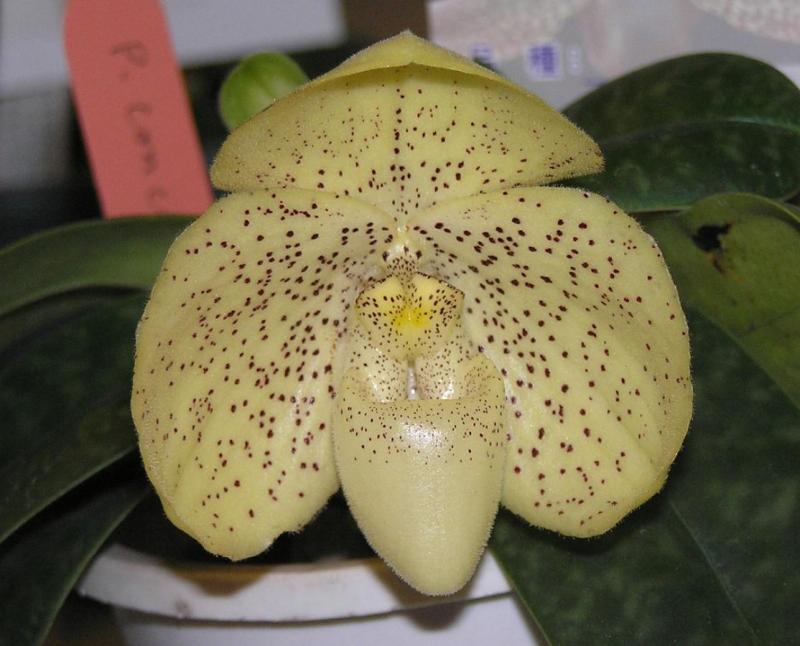Paphiopedilum concolor
Also known as: The One Colored Paphiopedilum or Paphiopedilum concolor var. dahuaense Paphiopedilum concolor var. immaculatum Paphiopedilum concolor var. longipetalum Paphiopedilum concolor var. concolor Paphiopedilum concolor h.f. striatum Paphiopedilum concolor f. dahuaense Paphiopedilum concolor h.v. stabilus Paphiopedilum concolor h.f. album Paphiopedilum concolor var. reynieri Paphiopedilum concolor var. tonkinense Paphiopedilum concolor var. sulphurinum Paphiopedilum josianae Paphiopedilum concolor var. trungkienii Paphiopedilum concolor h.v. regnierii Paphiopedilum concolor ssp. regnieri Paphiopedilum concolor f. sulphurinum Cypripedium concolor var. sulphurinum Cypripedium concolor var. reynieri Cypripedium concolor var. longipetalum Cypripedium concolor var. chlorophyllum Cypripedium tonkinense Cypripedium concolor var. tonkinense Paphiopedilum concolor h.v. hennisianum Paphiopedilum concolor var. chlorophyllum Paphiopedilum concolor ssp. chlorophyllum Paphiopedilum concolor ssp. hennisianum Paphiopedilum concolor ssp. Reynieri in the subfamily: Cypripedioideae
Native to: Cambodia China Thailand
General Information
The One Colored Paphiopedilum is a warm growing orchid belonging to the sub family Cypripedioideae native to Cambodia, China and Thailand.
Plant Description
Grows to 20-30cm. Each new growth has numerous elliptic oblong shaped leaves that grow to 3-15cm long. Pseudobulbs grow to 20cm
Flowers
Numerous blossoms appear during Spring
Blooming Season
- Spring
Substrate(s)
- Coarse
- Spaghnum Moss
Climate
Grows at low to high elevations. Rainfall ranges from 3mm to 224mm per day, heaviest in September and lightest in December. Humidity ranges from 59% to 82%, highest in September and lowest in March. Temperature ranges from 9C to 34C, highest in April (22C to 34C) and lowest in January (9C to 27C).
Watering
These orchids prefer a constant supply of moisture, with a slight drying out between waterings. Saucers can be placed under pots to retain moisture during hot weather, however the saucers should be removed or let to dry every 1-2 weeks to prevent rot. Keep an eye on the plant especially in hot weather and look for cues of under/overwatering and adjust accordingly.
Fertiliser
These orchids do not need to be regularly fertilised and roots may be sensitive to salt build-up, dying back and therefore impairing the plants growth or even killing it.
If fertilising, use half to quarter of the recommended amount of fertiliser. If they receive fertiliser as part of a collection, be sure to flush out the pots regularly with fresh water and monitor the roots by checking how much resistance is given by the plant when nudged in its pot or mount. If the plant becomes wobbly or loose, repot in fresh mix or rinse the media/mount thoroughly and do not fertilise for at least 3 months.
Be sure to flush out excess fertiliser by running water through the media regularly year round. This plant is sensitive so apply fertiliser sparingly at one quarter recommended strength or less. Use a high Nitrogen fertiliser year round. Use a high Phosphorous fertiliser during Summer.Potting
Due to the growth nature of these plants they are best mounted onto cork, tree fern slabs, or even trees if the climate suits. Water regularly especially in hot weather.
This plant does well mounted. Repotting is best done annually.




















